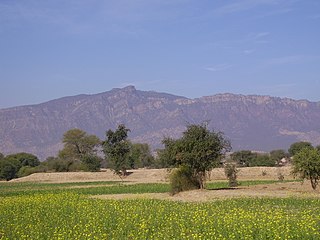Related Research Articles
Laur, Lava, Lavi or Lor is a major clan of the Gurjar ethnic community of northern India.

Doiwala is a town and a Nagar Palika in Dehradun district in the state of Uttarakhand, India.
Kalsian, also spelled as Kalsiyan, Kalsan or Kalsyan, is a clan of the Gujjar ethnic community based in India and Pakistan.

Gujari is an Indo-Aryan language spoken by most of the Gujjars in the northern parts of India and Pakistan as well as in Afghanistan. It is a member of the Rajasthani group of languages.
The Gurjar are an agricultural ethnic community, residing mainly in India, Pakistan, and Afghanistan, divided internally into various clan groups. They were traditionally involved in agriculture, pastoral and nomadic activities and formed a large heterogeneous group. The historical role of Gurjars has been quite diverse in society: at one end they have been founders of several kingdoms and dynasties and, at the other end, some are still nomads with no land of their own.

The Pothohar Plateau is a plateau and historical sub-region in northern parts of the Punjab region, present-day Punjab, Pakistan. Ethnic Punjabis are the native people of the area and are subdivided into many tribes and clans (Baradari).
Chopra, is a clan found in the Gurjar ethnic community of Pakistan and India.
Khatana is a major clan of the Gurjar community of India, Afghanistan and Pakistan. They follow several religions, including Hinduism, Islam, and Sikhism.
{{infobox caste | caste_name = Doi | image = | image_size = | alt = | caption = | abbreviation = | jati = | gotra = | religions = {{hlist|[[Islam][Hindu] }}
Chamayan is also referred to as Chamayin, Chamain or Chaim is a clan of the Gurjar ethnic group found in India and Pakistan. They adhere to many religions, including the Hinduism, Sikhism and Islam.
Thikariya or Thikriya is a subcaste of the Thakkar's clan, found among the Muslim and Hindu and possibly some sikh Gujjars. The variations of the clan name include Thikariya, Thikria, Thikaria, Thekaria, or Thekria..
Hakla, some time spelled as Haklla or Akla is a clan originally affiliated with the Gurjar/Gujjar ethnic group of south Asia. They are mostly found among the Hindu and Muslim Gujjars.
Bhumla or Bhumbla are a Gujjar/Gurjar Clan, as Bumla or Bhoomla. Mainly found in Punjab, Pakistan, Punjab, India and Haryana, India, they can be found amongst Muslims, Hindus and Sikhs. The most spoken languages in this clan are Punjabi and Haryanvi. Bhumbla Gujjars can also be found in KPK Pakistan and Afghanistan.
Gegi, Gaigi, or Gegian is a clan (subcaste) of the agricultural Punjabi Gujjar community of Punjab. Their main villages are found in Jehlum, Gujjaranwal, and Gujarat districts in the central Punjab. But their also found in Jammu and Kashmir, Gilgit-Baltistan and Pakistani-administrated-Kashmir.

Javaid Rahi is an Indian author, researcher and tribal social worker. He is a writer and poet of Gojri, Punjabi and Urdu languages. He has written 25 books and edited over 300 books and issues of magazines in different languages especially in the field of tribal literature, history, and culture of pastoralists including Gujjars, Bakarwals, Shina-Dard, Sippis, and Gaddis— and other Scheduled Tribes groups of India.
Charr/Charrh/Char is a sub clan of Gurjar/Gujjar ethnic group of India,Pakistan & Afghanistan.
Chechi, is a clan of the Gurjar community in Afghanistan, Pakistan, and India. That is prevalent among the Hindu, Sikh, and Muslim Gujjars.

Muslim Gujjars or Musalmān Gujjars are an ethno-religious group predominantly found in the north-western regions of South Asia. They embraced Islam from the medieval period onwards.
Bajjar or Bajar is a clan of Gujjar community. They are mainly found in Punjab, Pakistan, Kashmir, Himachal Pradesh, Punjab, India, Balochistan and Khyber Pakhtunkhwa.
References
Citations
- ↑ Khari, Rahul (2007). Jats and Gujars: Origin, History and Culture. Reference Press. p. 85. ISBN 978-81-8405-031-8.
The Gujar clans of Ghaziabad , Meerut are Baisla Pawar Adhana Mavi Awana & Kasana.
- ↑ Shashi, Shyam Singh (2006). The World of Nomads. Lotus Press. p. 110. ISBN 978-81-8382-051-6.
- 1 2 Kumar, Raj (2008). Encyclopaedia of Untouchables Ancient, Medieval and Modern. Kalpaz. p. 446. ISBN 978-81-7835-664-8.
Gujar sections: Awana, Ludhiana, Hoshiarpur and Gujarat: Awana, Hazara
- ↑ Contemporary Social Sciences. Research Foundation of India. 1978.
- ↑ Rahi, Javaid. The Gujjars -Vol 04 (Gujjars History & Culture) by Dr. Javaid Rahi. Jammu and Kashmir Acacademy of Art, Culture , Languages , Jammu.
Notes
- Henry Adolphus Byden Rattigan (1895) A Digest of the Cases Reported in the Punjab Record:With an Index of the Names of the Cases · Volumes 28-30 Civil and Military Gazette Press. p.80
- K. S. Singh, Swaran Singh, V. Bhalla (1997) Chandigarh Chandigarh, India, culture, society. p.66 "The community has a number of clans. The principal clans are Barsoi, Dhanga, Chamayan, Chhokar, Khatana, Rawal, Khare, Seradra, Pilwara, Awana, Kumbar, Madi, Chechi, Koli, Chadri, Chanda, Mutan, Nikari, Rawat, Rajana, Budana."
- A. H. Bingley, Krishna Prakash Bahadur (1978) History, Caste & Culture of Jāts and Gūjars Ess Ess Publications. p.44